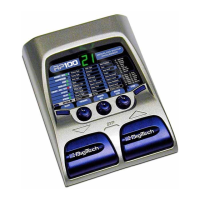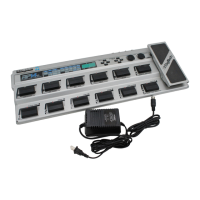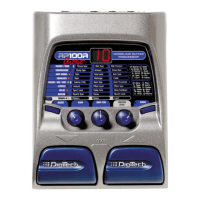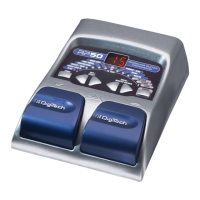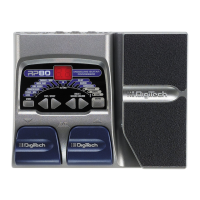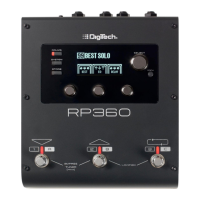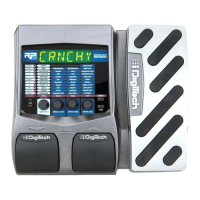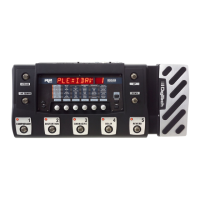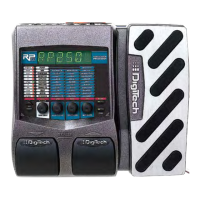Do you have a question about the DigiTech RP150 and is the answer not in the manual?
| Type | Multi-Effects Processor |
|---|---|
| Effects Types | Distortion, Modulation, Delay, Reverb, etc. |
| Power Supply | 9V DC adapter (included) |
| A/D/A Conversion | 24-bit |
| Sampling Rate | 44.1 kHz |
| Presets | 100 |
| Display | LED |
| Inputs | 1 x 1/4" Instrument |
| Outputs | headphone output |
| Expression Pedal | Yes |
| MIDI | MIDI In/Out |
| USB | USB connection for updates and data transfer |
Explains internationally accepted symbols warning of potential hazards with electrical products and user safety.
Details the unit's compliance with product specifications and conditions for operation regarding interference.
Introduces the RP150, highlighting its features and capabilities for creative guitar processing.
Lists the essential components included with the RP150, such as the unit, power supply, and warranty card.
Describes the default operating mode for accessing presets using the footswitches and control knobs.
Explains how to engage the analog bypass circuit for a clean, unprocessed guitar signal.
Details how to enter and use the built-in tuner to quickly tune or check guitar tuning.
Explains how this knob selects genre-based amp tone defaults and refines sounds via presets.
Describes selecting post-amplifier effect chains and refining sounds via presets.
Details how to adjust effects level and master volume using specific knobs.
Introduces the computer software for editing and managing RP150 presets and settings.
Explains presets, user vs. factory types, recall methods, and loading via library knobs.
Identifies and describes the main controls and features located on the front panel of the RP150.
Explains the function of the two footswitches for selecting presets, tuner access, and bypassing.
Details the various functions of Knobs 1-4 depending on the active mode or editing state.
Explains the functions of Knob 3 (Effects Level) and Knob 4 (Master Volume) in different modes.
Describes the Edit buttons for navigation and the Matrix LEDs for status and editing feedback.
Details how the display provides information based on the selected mode (Performance, Edit, Tuner).
Explains how to enable, control, and use the RP150's built-in drum machine.
Describes the function of the Store button for saving custom edits to user presets.
Details the high-impedance TS input for connecting your instrument.
Explains how the switch optimizes outputs for guitar amps or mixers/recording devices.
Describes connecting mono or stereo outputs to amplifiers or mixer channels.
Details the 1/8" stereo jack for headphone connection and recommended impedance.
Explains connecting a passive volume or control pedal to the Control In jack.
Details USB connection for software editing, librarian functions, and audio streaming.
Specifies connecting the dedicated DigiTech PS0913B power supply to this jack.
Provides guidance on connecting the RP150 to your amplifier or other gear before applying power.
Details how to connect the RP150 for mono output to a guitar amplifier, setting Amp/Mixer switch.
Explains connecting the RP150 for stereo output to two amplifiers, including Amp/Mixer switch setting.
Illustrates connecting the RP150 to a mixer for stereo operation and proper panning.
Details connecting the RP150 to a computer for recording with studio monitors.
Provides step-by-step instructions for safely applying power to the RP150 and amplifier.
Explains the process of editing existing presets or creating new custom sounds using the RP150.
Details how to select a preset, use knobs to find sounds, and edit effect parameters.
Explains the importance of the Store button LED and how to save changes to avoid data loss.
Outlines the steps to store modified settings to user preset locations or copy presets.
Explains the RP150's virtual amplifiers and stompboxes and how their connection order affects sound.
Describes the Pickup Simulator effect, its models, and how to adjust its parameters.
Details the Wah effect, its models, and parameters like Wah Minimum, Maximum, and Level.
Explains the Compressor effect, its models (DC, CS), and parameters like Sustain, Tone/Attack, and Level.
Lists the 9 popular distortion stompbox models available and how to select them.
Details the functions of Knobs 2, 3, and 4 for various Distortion models (Gain, Tone, Level, etc.).
Explains Amp Modeling and lists the classic, modern, and custom amp models available.
Lists the speaker cabinet models available for use with the Amp models.
Details how to adjust Amp Gain (distortion) and Amp Level (volume) for selected amp models.
Explains the EQ controls (Bass, Midrange, Treble) and preset EQ curves.
Details the Noise Gate effect, its models (Gate, Swell), and threshold/sensitivity settings.
Explains the Chorus effect, its models (CE, DC, MC), and parameters like Speed, Depth, and Level.
Details the Flanger effect, its models (FL, MX), and parameters like Speed, Depth, and Regeneration.
Explains the Phaser effect and its parameters: Speed, Depth, Regeneration, and Waveform.
Details the Tremolo effect, modulating volume at an even rate, and its parameters.
Explains the Auto Panner effect, modulating sound from left to right, and its parameters.
Describes the Vibrato effect, modulating pitch at an even rate, and its parameters.
Details the Rotary Speaker emulation, its parameters like Speed, Intensity, and Doppler.
Explains the Auto Ya™ effect, combining Wah and Flanger for vowel-like characteristics.
Describes the Envelope Filter, a dynamic Wah effect sensitive to playing intensity.
Details the Step Filter, an automatic 'random wah' with a square waveform, and its parameters.
Explains the Detune effect, creating a doubling sound by slightly tuning a copied signal.
Describes the Pitch Shift effect, copying and shifting pitch to create harmony or layered sounds.
Explains Intelligent Pitch Shifting for harmonizing, detailing Shift, Key, Scale, and Level parameters.
Details the Whammy effect, using an expression pedal for pitch bending and harmony, and its parameters.
Lists the 5 different Delay models available (Analog, Digital, Modulated, Pong, Tape) and their controls.
Lists the available Reverb models (Fender, Lexicon, EMT) and their parameters like Decay and Level.
Details the RP150's drum machine, listing available patterns for various styles and metronome settings.
Explains connecting a passive volume or control pedal to the Control In jack.
Details the procedure for resetting the RP150 to original factory settings, warning about data loss.
Provides key technical specifications including converters, DSP, memory, dimensions, and weight.
Details the specifications for analog input and output jacks, including impedance and maximum output.
Details USB connection type, speed, and RP150 USB recording specifications.
Lists power requirements by region and minimum system requirements for PC and Mac computers.
Provides a comprehensive list of the available tones in the RP150's Tone Library.
Provides a comprehensive list of the available effects and effect chain combinations in the Effects Library.
Lists all user and factory presets with their corresponding names for quick reference.

